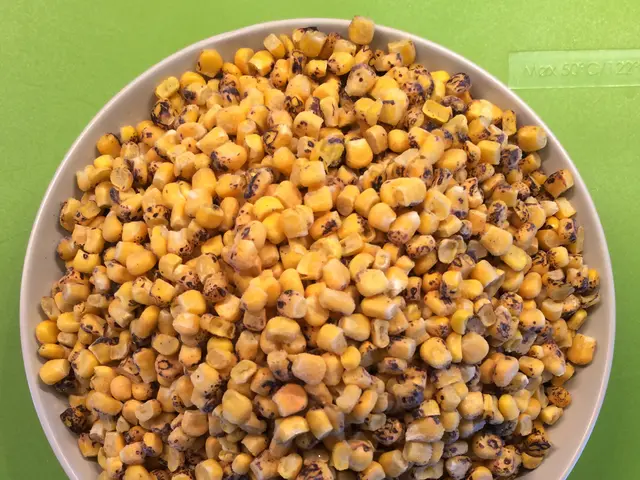Achieving Astonishing Glute Strength through Hip Thrust Techniques
Boost your behind and strengthen your entire posterior chain with hip thrusts - the crowd-pleasing exercise that targets your booty and so much more! Discover why this move is essential for building a muscular booty and improving your athletic performance.
Hip thrusts, essentially elevated glute bridges, are popular among weightlifters for their unique ability to effectively tone the butt muscles. But they're perfect for anyone looking to build strength, enhance flexibility, and boost mobility. So, if you want a strong, sculpted posterior, it's time to give hip thrusts a shot!
Let's Talk Techniques
To perform hip thrusts, you'll need a sturdy bench or box. Here's what you need to do:

- Rest your upper back on the bench, with your knees bent, feet flat on the floor, and hips-width apart. Your butt should be slightly off the floor.
- Keeping your chin tucked, press through your heels until your thighs are parallel with the floor, forming a 90-degree angle.
- Squeeze your glutes at the top of the move, hold for a few seconds, then slowly return to the starting position. Repeat.
The Muscles Behind the Magic
Hip thrusts primarily work your glutes - the gluteus maximus and gluteus medius. They also provide a great workout for your hamstrings and quads, core, and hip adductors.

Curious about glute bridges? While they're similar, they're performed from the floor and work your quads more and your hamstrings less due to the lack of elevation. Add both exercises to your routine for optimal booty gains!
Beyond the Booty: The High Sprinting and Athletic Gains
Strengthening your glutes through hip thrusts can help reduce your risk of knee and lower back pain and injuries. It can also lead to athletic gains like higher jumps, faster sprints, greater glute and mid-thigh strength, and better agility[3].

In a 2019 review of studies, researchers concluded that the hip thrust with barbells significantly improved study participants' short sprint times and led to greater activation of the hip extensors than other exercises[4].
Perfecting Your Form
For the best hip thrust results, follow these guidelines:

Do:
- Complete the full range of motion, ensuring your glutes are fully activated.
- Keep your back neutral, and your ribs angled down and low back neutral.
- Maintain heel contact throughout the movement.
Don't:

- Put your feet too far forward.
- Come up onto your toes.
Adding Weights
If you're a hip-thrusting pro, consider adding weights to amplify the challenge. You may use a dumbbell, weight plate, barbell, or even a Smith machine.

Mix It Up: Hip Thrust Variations
Keep things interesting with hip thrust variations like single-leg versions, hip thrusts off a higher bench or couch, banded hip thrusts, and glute bridges.
In Closing
Hip thrusts are a versatile exercise that offers numerous benefits for building strength, improving athletic performance, and aiding in flexibility. Whether you're a beginner or an experienced fitness enthusiast, add hip thrusts to your routine for amazing results!
And if you're uncertain about your form, consult a fitness professional for guidance.
Enrichment Data:- Hip thrusts are highly effective for building the size and strength of the gluteus maximus muscle, which is crucial for hip extension and overall lower body strength[1][5].- The strong glutes developed through hip thrusts can enhance sprint speed, jump height, and ability to change direction quickly[2].- Strengthening the glutes helps with daily activities like walking, climbing stairs, and maintaining balance. It also aids in stabilizing the sacrum to prevent lower back pain and posture issues[1][5].- Hip thrusts help balance tight hip flexors by strengthening the hip extensors (glutes), which can prevent anterior pelvic tilt and maintain proper posture[1].- As a weight-bearing exercise, hip thrusts can improve bone density in the hips, knees, and spine, making them beneficial for long-term health without the high impact stress of other exercises[1].- Hip thrusts can be performed with various resistance levels, from bodyweight to barbells, making them suitable for all fitness levels[1][5].
- For weightlifting enthusiasts and those seeking fitness, hip thrusts are a highly effective exercise to tone the butt muscles, thanks to their ability to isolate the gluteus maximus and gluteus medius.
- To boost your bodyweight strength and flexibility, consider incorporating hip thrusts into your workouts, as these exercises also target the hamstrings, quads, core, and hip adductors.
- If you're ready to challenge yourself, consider adding weights such as dumbbells, weight plates, barbells, or Smith machine for a more resistance-based hip thrust workout.
- Employ variations like single-leg hip thrusts, band-resisted hip thrusts, or elevated hip thrusts to inject some excitement into your routine and target different aspects of your glutes and flexibility.
- Before you jump into hip thrust workouts, ensure you understand the proper technique to isolate the glutes effectively, maintaining a neutral back and heel contact throughout the movement.
- Whether you're new to fitness or a seasoned athlete, hip management and hip thrusts can help strengthen your entire posterior chain, promoting better overall athletic performance, reducing the risk of lower back pain and injuries, and aiding in daily activities.






